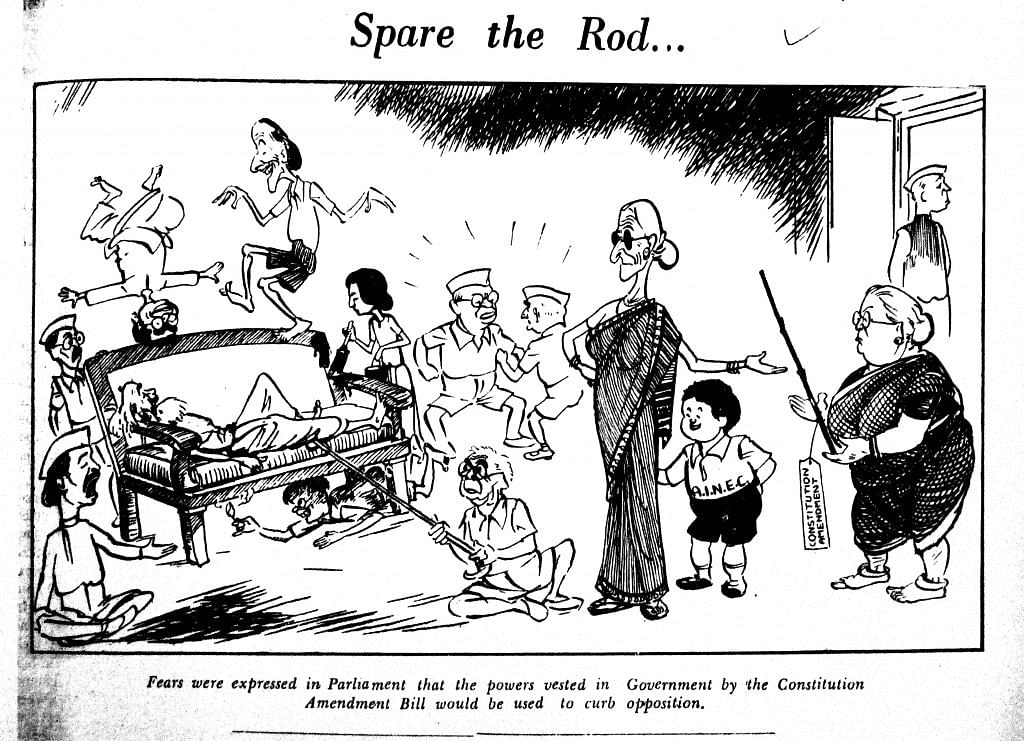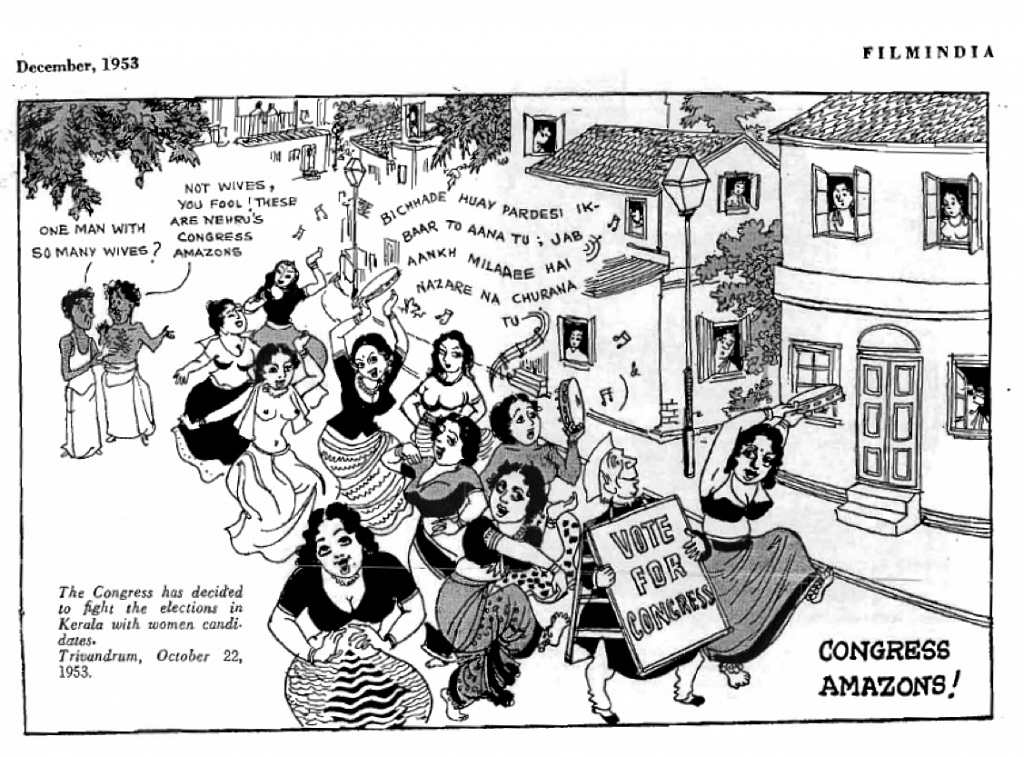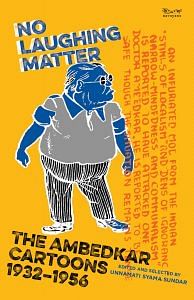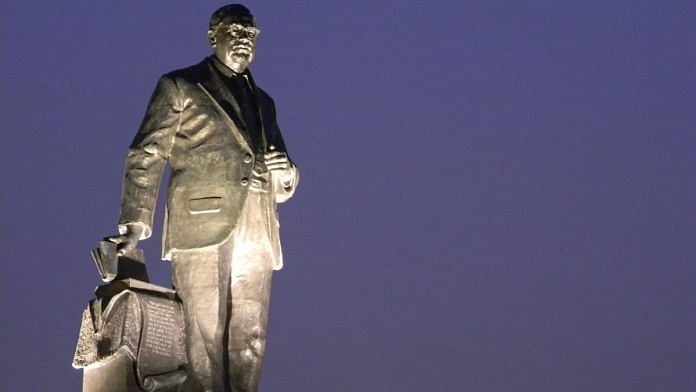Cartoonist and scholar Unnamati Syama Sundar felt compelled to look at the way Babasaheb Ambedkar was represented in political cartoons following the 2012 NCERT cartoon controversy where a Class XI textbook carried an image of a snail-borne Ambedkar being whipped by Jawaharlal Nehru. Four years of his search and research has resulted in No Laughing Matter: The Ambedkar Cartoons, 1932–1956 (published by Navayana) featuring 122 cartoons with extensive context and commentary. Here’s an excerpt from Syama Sundar’s introduction to the book:
If [B.R.] Ambedkar’s appearance in cartoons signals his growing role as a shaper of history, the caricatures of him all too frequently replace one idiom of prejudice and subjugation with another, casteist slurs sliding into the easy sexism of the cartoonist. If Shankar likes showing Ambedkar as a woman who sleeps around, so does a Bireshwar or Enver Ahmad. The misogyny of cartoonists—on liberal display even when on the surface many of them were on Ambedkar’s side during the Constituent Assembly debates or during the acrimonious debates over the Hindu Code Bill—did not limit itself to Ambedkar. Showing Nehru or Rajagopalachari or the less remembered socialist leader Asoka Mehta as a woman was common too. Consider this:

While Rajaji appears as the school headmistress, Ambedkar, wearing no chappals, appears to be a maidservant dressed in Maharashtrian fashion in a Shankar cartoon about the First Constitutional Amendment Bill that discussed curbs on the freedom of press. In another cartoon (p. 326), drawn in 1951 after Ambedkar quit the Congress government, Shankar depicts Ambedkar as Draupadi excited about sleeping with five partners. Would this serve to explain the problems of alliance politics in a textbook meant to foster ‘critical pedagogy’? Should students, many already schooled in caste stereotypes, be given the freedom to make what they wish of such images? Alaka Shankar speaks of how a cartoon he produced in Hindustan Times after being chief guest at Lady Irwin College in Delhi ridiculed the young women he had seen there wearing lipstick. The caption read: ‘Thinking of opening a Lipstick Service Station at Connaught Place’. This angered progressive women activists so much that Rajkumari Amrit Kaur even complained to Gandhi about it. Here’s one from Film India, likely by Eeran, from 1953, that parades its predilections brazenly:

It was only after Ambedkar came to pilot the Constituent Assembly and later joined the Nehru cabinet as law minister that both reporters and cartoonists were forced to devote regular column space to him. Often when a newspaper carried positive reports on Ambedkar, the cartoonists deliberately targeted Ambedkar even if there was nothing really to make fun of. For instance, when news of the third reading of the Constitution appeared in National Herald (20 November 1949) with the headline “More praise than criticism on Ambedkar’s Constitution”, Ambedkar was lampooned on the following page by Bireshwar (see “Kaliyug Bhim”, p. 242).
One of the lines of defence of those who had no issues with “The snail and the whip” cartoon in the NCERT textbook went like this: surely, Ambedkar himself must have seen the cartoon and there’s no record of him objecting to it, so why are dalits today making politics out if it? In the last stages of work on this book, we received some information that could not be thoroughly investigated but its veracity is not in doubt. During the debates on the Hindu Code Bill from 1948 to 1951—a subject on which you will find thirteen cartoons in this book—Surat Singh Shekhawat published a cartoon in Hindustan Times. News of this came to us from Rajasthan through the grandson of Shekhawat, Yashvardhan Singh Shekhawat, an independent political activist (who even contested the 2018 Rajasthan elections). Like the Birlas, this Shekhawat family hailed from Pilani. Surat Singh Shekhawat, a rajput, was trained at the J.J. School of Art in Bombay and worked at Hindustan Times as a cartoonist. He was a close associate of Shankar and had made a cartoon on what he and some critics felt were obsolete provisions that had been included by Ambedkar in the controversial Hindu Code Bill.
Shekhawat conveyed his critique by showing Ambedkar dragging the carcass of a buffalo outside parliament, with a Rajasthani-slanted Hindi caption that meant: what is the purpose of dragging around a dead weight? Ambedkar was livid. After all, the mahar caste to which he belonged, was meant to dispose of dead cattle. He filed a defamation suit against Shekhawat and Hindustan Times. Ambedkar felt that he had been slighted on the basis of his caste. G.D. Birla had to personally intercede and explain to Ambedkar that Shekhawat was indeed a rajput but of a ‘progressive’ kind, that he did not mean to insult Ambedkar’s caste and had just conveyed the spirit of a common saying in Rajasthani. It was pointed out to Ambedkar that Shekhawat had attended a dalit baaraat (wedding procession) in 1946, considered to be something worthy in those times (and sadly even now). Before his death in 2011, Shekhawat recounted this forgotten cartoon controversy in an interview to the television channel ETV Rajasthan in 2009. We are not sure we would have featured this image even if we had laid our hands on it.
Shekhawat’s defence was that his was an innocuous use of imagery associated with a well-known saying. Language and idiomatic speech in India are of course saturated with caste prejudice. One famous saying by Tulsidas (Gandhi’s favourite poet) from the Ramcharitmanas goes: Dhol ganvar shudra pashu naari, sakal tadna ke adhikari. It means: A drum, an idiot, a shudra, cattle and women/ if they need to be straightened, they need to be beaten. The smooth insult, sometimes sounding even musical, is part of savarna speech habits; and Parthian shots, in our times, often wield the arrows of the law (that Ambedkar helped craft). This is the reason why we belatedly have the Scheduled Castes and Scheduled Tribes Prevention of Atrocities Act that outlaws the habitual and casual recourse to derogatory language towards dalits (such as when free speech leads a renowned intellectual to say, ‘It is a fact that most of the corrupt come from OBCs and Scheduled Castes and now increasingly the Scheduled Tribes’).
We take all this in with the sobering awareness that things have not changed much when it comes to depictions of the caste issue or of dalit public figures in cartoons (or for that matter in most savarna-controlled spaces) in contemporary India. We surely do not live in a more enlightened time.
 This excerpt from No Laughing Matter: The Ambedkar Cartoons, 1932–1956 has been published with permission from Navayana.
This excerpt from No Laughing Matter: The Ambedkar Cartoons, 1932–1956 has been published with permission from Navayana.




This is a pure example what happens when you keep your brain aside for marketing strategies. I think the cartoonist has done the same. I appreciate that you people have the guts to show this but presence of mind is really important. Are the issues based on casteism less that you have this article to post? I think you know that Dr. Babasaheb Ambedkar is so highly respected in n outside our country. Posting such information can create a drift in society. Hope you get that.
Dear cartoonist please don’t see everything in you please see you in everything
Ambedkar Article
https://www.sociologygroup.com/ambedkar-research-perspectives-chapters/
To everyone criticising the article and it’s timing.
It isn’t surprising that you find it useless, because you’ll don’t actually care or respect Dr Ambedkar. So you’ll aren’t offended by the cartoons at all. You don’t even want people to know the kind of offensive and inappropriate opinion that anti Ambedkarites used to have and have even today. Just sweep it under the rug. Had this been about Rama or some savarna personality people would’ve shamed the Print and asked questions like “How dare you?”
I personally wasn’t aware about such cartoons being in existence and got to know about it through the article. And I am glad you did.
The Print brings out truth always. Keep it up.
So,How grand did you celebrate this article??
Stupid person, atleast learn to respect the one who has written the constitution, I know you maybe some casteist , but mind you, this article has benefitted nothing to the society , except an insult to this great leader.
Your brain is incapable to see the greatness of this person because of blind folded by casteist mentality, so you could come up with praising this bloody reporter..
Anyways kudos to your pathetic life
Bloody hell
Very apt comment
Hopeless articles
It is really unfortunate of India if we do such type of unnecessary things how can we make castles and class less society some people should understand the reality of Dr ambedkar honestly he tried to reform Indian society towards anihilation of caste from 1936 to 1956 around twenty years but it did not work ending he said for India to make right reforms like kamalesh of turkey and Hitler of Germany dictators are required so do not do the criticism without reason and meaning please don’t try to do such type of waste works try to avoid the dividing Indian society
It is indeed useless article.As the political parties play the game of divide and rule the same policy the media has applied. Most of the media channels are sold out by the politicians and media speak what the politicians want.If the dalits were given the work of dragging animals who gave them this work. what right did that person have.who was he .it means there was inequality.discrimination.need to learn history.learn to respect.
It’s Madness.
Useless article
Well the temptation of be littling India and its people is irresistable by The Print. What is the purpose of writing this article and opening the graves for whose benefit ?!
Just one comment, but whoever has commented, commented rightly .
We are just out of a bitter election and you guys have decided again to divide the society ..Please have some sensitivity …what a shame ..this is not the time to publish this …these articles make ordinary people like me feel that media is out there to divide the otherwise peaceful ppl of India ..shame